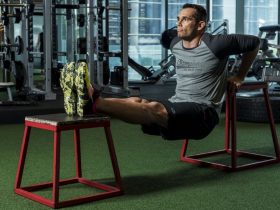Achieving a favorable body composition is more than just a matter of losing weight or building muscle. It is about optimizing the balance of lean mass versus fat mass in the body, ultimately enhancing physical health, performance, and appearance. While the basics—such as proper diet and regular exercise—are crucial, taking a more advanced, tailored approach can accelerate progress and yield sustainable results. For those who have mastered the basics and are looking to refine their approach, understanding advanced strategies for improving body composition is essential.
In this article, we’ll explore effective and science-backed methods that go beyond the typical gym routine or calorie counting. These strategies will provide you with a comprehensive roadmap to improve your body composition, increase muscle mass, reduce body fat, and achieve your physique goals.
1. Track and Optimize Your Macronutrient Ratios
When it comes to body composition, the quantity and quality of macronutrients—proteins, carbohydrates, and fats—are far more important than simply adhering to calorie goals. Understanding how to balance these nutrients according to your body’s needs can have a profound impact on fat loss and muscle gain.
Protein: Protein is the foundation for muscle repair and growth. If you’re aiming to improve your body composition, you should prioritize protein intake. Research suggests that consuming about 1.6–2.2 grams of protein per kilogram of body weight per day can help stimulate muscle protein synthesis (MPS) and promote fat loss while preserving lean muscle. Additionally, consuming protein-rich meals throughout the day, particularly after workouts, can further boost MPS.
Carbohydrates: While carbohydrates are often vilified, they play an essential role in providing the energy necessary for muscle building and fat loss. Complex carbohydrates, such as whole grains, vegetables, and legumes, provide sustained energy for high-intensity workouts and aid in muscle recovery. Adjusting your carbohydrate intake based on your activity level is key. On rest days, you may reduce carb intake to prevent excess storage of glucose as fat, while on intense training days, you may increase carbs to replenish glycogen stores and support recovery.
Fats: Healthy fats are crucial for hormonal balance, which is central to body composition changes. Diets rich in omega-3 and omega-6 fatty acids support fat loss by regulating insulin sensitivity and reducing inflammation. Incorporate sources such as avocados, nuts, seeds, and fatty fish. Be mindful of your fat intake, however, as excess fat can still contribute to weight gain if it leads to a caloric surplus.
2. Prioritize Resistance Training Over Cardio
While cardio can burn calories and help with fat loss, resistance training is indispensable for transforming body composition. Engaging in regular strength training helps you build lean muscle mass, which increases your resting metabolic rate (RMR) and accelerates fat loss in the long term. Muscle is more metabolically active than fat, meaning the more muscle you have, the more calories you burn at rest.
Focus on compound movements such as squats, deadlifts, bench presses, and rows. These exercises engage multiple muscle groups, stimulate growth, and enhance metabolic efficiency. Additionally, progressive overload—gradually increasing the resistance or volume of your training over time—forces your muscles to adapt and grow stronger.
Aim for at least 3-4 strength training sessions per week, incorporating both upper and lower body exercises, with a focus on full-body routines. As you progress, challenge your muscles with higher intensity workouts, such as adding supersets, drop sets, or lifting heavier weights.
3. Incorporate High-Intensity Interval Training (HIIT)
While steady-state cardio has its place, High-Intensity Interval Training (HIIT) is a game-changer when it comes to body composition. HIIT involves alternating between short bursts of intense exercise and periods of rest or low-intensity activity. This method not only burns calories during the workout but also elevates your metabolic rate for hours after training, a phenomenon known as excess post-exercise oxygen consumption (EPOC).
HIIT is incredibly effective for fat loss while preserving lean muscle mass, making it a valuable tool for those looking to improve their body composition. Studies have shown that HIIT can reduce visceral fat (the fat surrounding internal organs), which is linked to chronic diseases. Additionally, HIIT training can improve cardiovascular fitness, endurance, and insulin sensitivity.
A simple HIIT workout might involve 30 seconds of all-out sprints on a stationary bike, followed by 60 seconds of slow pedaling, repeated for 20-30 minutes. Incorporating HIIT sessions 2-3 times per week can yield significant improvements in both fat loss and muscle retention.
4. Focus on Nutrient Timing
Nutrient timing refers to the strategic consumption of certain foods around your workout to optimize performance, muscle gain, and fat loss. When you exercise, your body is primed to absorb nutrients, and what you eat before, during, and after a workout can enhance the results you see from your training sessions.
Pre-Workout Nutrition: Consuming a balanced meal 1-2 hours before exercise that contains protein and complex carbohydrates can provide sustained energy during your workout. A small protein shake with some fruit or a bowl of oatmeal with nuts and berries can fuel performance and help prevent muscle breakdown.
Post-Workout Nutrition: After a workout, the body is in a catabolic state, meaning it is primed for muscle recovery. Consuming a combination of protein and carbohydrates within 30-60 minutes post-exercise helps replenish glycogen stores, repair muscle tissue, and stimulate muscle protein synthesis. A protein shake with a piece of fruit or a chicken and quinoa bowl are excellent post-workout options.
Timing your meals around your workouts, especially when focused on muscle gain or fat loss, can amplify the results of your training.
5. Optimize Sleep and Stress Management
While nutrition and exercise are key factors, sleep and stress management are often overlooked components of body composition. Lack of sleep or chronic stress can hinder your progress by disrupting hormone levels that regulate metabolism and appetite. For example, insufficient sleep leads to elevated cortisol levels, which can promote fat storage, particularly around the abdominal area. Moreover, sleep deprivation has been linked to increased hunger and cravings for unhealthy foods.
Aiming for 7-9 hours of quality sleep per night is essential for hormone regulation, muscle recovery, and fat loss. Stress management techniques such as mindfulness, meditation, yoga, or deep breathing exercises can help reduce cortisol levels, improve mental well-being, and keep your body in a more favorable environment for fat loss.
6. Consider Supplements Wisely
While no supplement can replace a balanced diet and exercise routine, certain supplements can support body composition goals when used in conjunction with proper lifestyle practices. However, it’s important to approach supplementation with caution, focusing on well-researched products.
-
Protein Supplements: Whey protein, casein, or plant-based proteins can help ensure you meet your daily protein needs. Consuming protein post-workout supports muscle recovery and growth.
-
Creatine: Creatine is one of the most researched and effective supplements for enhancing strength and muscle mass. It helps improve performance during high-intensity training, increasing the ability to lift heavier weights and train longer.
-
Branched-Chain Amino Acids (BCAAs): BCAAs can help reduce muscle breakdown during prolonged exercise sessions, especially in a calorie deficit, which is important for preserving lean muscle mass while losing fat.
-
Caffeine: A natural stimulant, caffeine can increase energy expenditure and enhance fat burning during exercise. However, it should be used judiciously to avoid dependence or adverse effects.
7. Stay Consistent and Be Patient
Perhaps the most advanced strategy for body composition is the simple art of consistency. Changes to body composition take time, and while advanced strategies can speed up progress, results are not instantaneous. It’s important to stay committed to your nutrition plan, exercise routine, and recovery practices. Monitor your progress periodically, adjusting your approach as needed, but understand that patience and persistence will ultimately yield the best results.
Conclusion
Improving body composition is a complex but rewarding journey that requires a multifaceted approach. By fine-tuning your macronutrient ratios, prioritizing resistance training, incorporating HIIT, and managing sleep and stress, you can make significant strides in transforming your body. Advanced strategies—such as optimizing nutrient timing, considering supplements, and maintaining consistency—offer additional layers of refinement to accelerate your progress.
Ultimately, the path to an optimal body composition requires a blend of science, discipline, and patience. By incorporating these advanced strategies into your routine, you can achieve lasting improvements in your physique and overall health.









